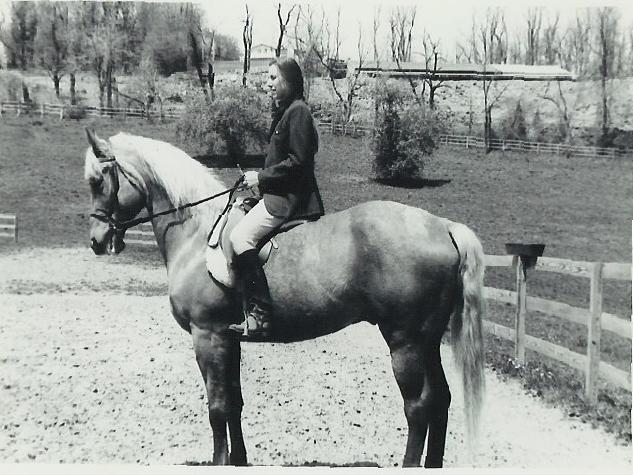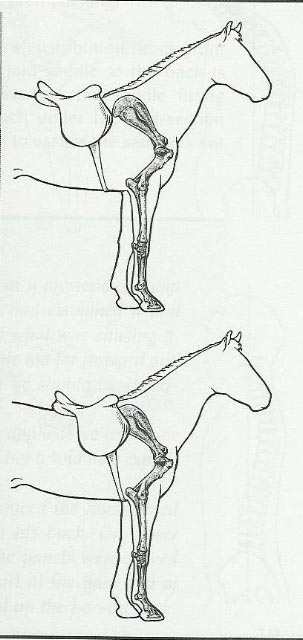|
From the Archives....
| Who is this rider? Any guesses? |

|
| Boy does she ever need lessons before this horse is ruined! |
Here is a picture of someone who has a lot wrong. First, the saddle is way
too forward -- it is sitting on the horse's shoulder. Ouch! Next, the rider is obviously pulling on the horse's mouth to get
it to drop its nose and give at the poll. Another ouch!
If this horse were trotting, it would have a short stride since its neck is
crunched. It may look as though the rider has a good straight line elbow to bit, but actually her hands are over the pommel
of the saddle and her elbows are behind her hips. She needs to allow this horse to stretch its neck forward onto the bit by
bringing her elbow slightly forward, not compressing the neck backwards. Also, the rider is sitting in a chair seat with the
ankle out in front of the hip. For correct alignment the ear, shoulder, hip and ankle should be in one straight line. The
rider's boots are dirty and this detail takes away from the otherwise nice attire, but, the dirty boots accentuate the fact
that her toe is sticking out, and the flat side of the hip is not on the saddle allowing the hips to open. She should drop
the foot out of the stirrup, let the leg hang down, grab the back of the thigh to rotate the knee in and open the hip and
get the foot and toes facing 5 to midnight, instead of 10 after midnight. And, a pet peeve, the mane is on the wrong side.
(See picture below of saddle fitted too far forward.)
Photo of how a saddle is not supposed to sit on the
horse's shoulders, interfering with its forward swing.

|
| Picture taken from Doris Halstead's book, "Release the Potential". |
News...News...News!
Release the Potential author Doris Halstead was in Saxonburg
in September. Dakota and Johannis went to have a session with Doris. Let me tell you they enjoyed it. When they arrived at
Braeface Farm, owned by Mary Schoder, they walked into a 12x12 stall and awaited their muscle therapy treatment. The hay there
was great and the air was different. If could have been Mary's herb garden just outside the barn. Doris found different issues
with each horse. She evaluated each horse first to check out their symmetry then she went to work. Doris' back ground is in
physical therapy, but because she is an avid dressage enthusiast, she started working on horses too. Since, she has written
two books, the one above and a new one called Awakening Rider's Pelvic Movement. Doris spent time with each horse first
adjusting their shoulders. You know how your horse may throw his shoulder out, and you spend years trying to correct it...Doris
did this by applying pressure to certain trigger point areas within the horse to get the muscles to release. She says each
adjustment she does has to be non threatening to the horses, small and familiar. If a horse feels threatened, it won't be
able to release. This only makes sense. She did adjustments to both horse's poll areas and their "gelding scars". This area
where the geldings have been cut, holds a lot of tension according to Doris. She held the empty sack until the horse relaxed
and let it go. Of course, doing this to your own gelding is not recommended without first knowing how he already feels about
his "gelding scar". What Doris recommends is reading her book Release the Potential. She says every thing she did to
Johannis and Dakota is in the book. I, of course, ordered the book, and she is right -- this book is so simple to follow and
laid out with great pictures. If you see me groping behind your horse pulling its tail, massaging its gums or flexing the
crest of its neck, you can be sure that I learned it from Doris Holmstead. To buy her book, contact Amazon.com, or ask your
favorite book store or tack store to order one. And, don't forget the book about the rider's pelvis, too. Or, if you would
like to see my copies just ask.
|



